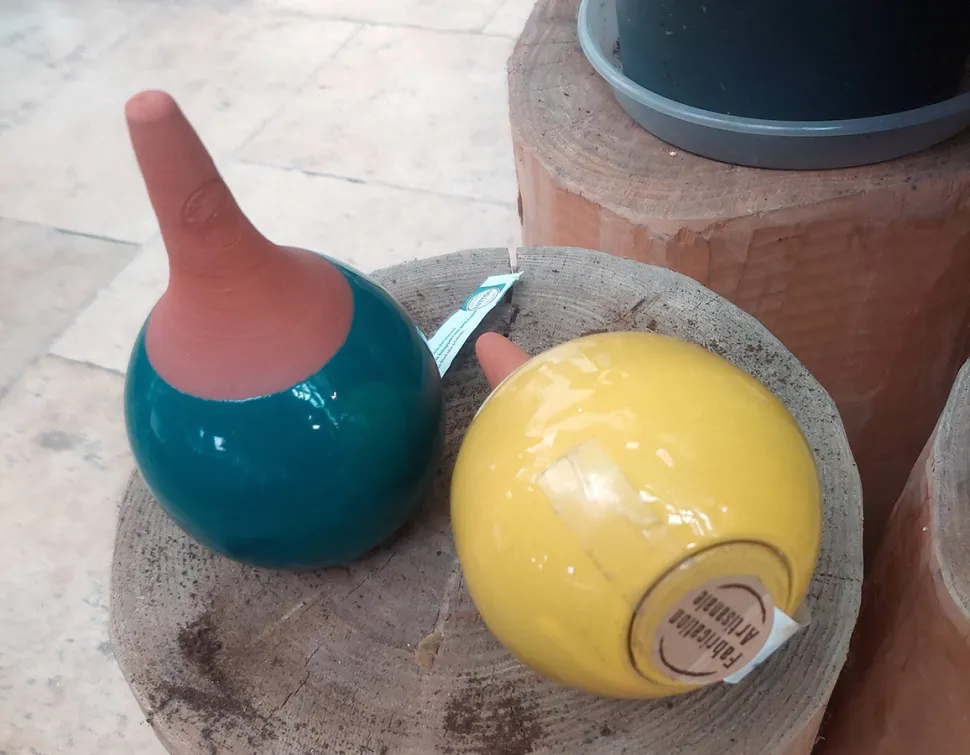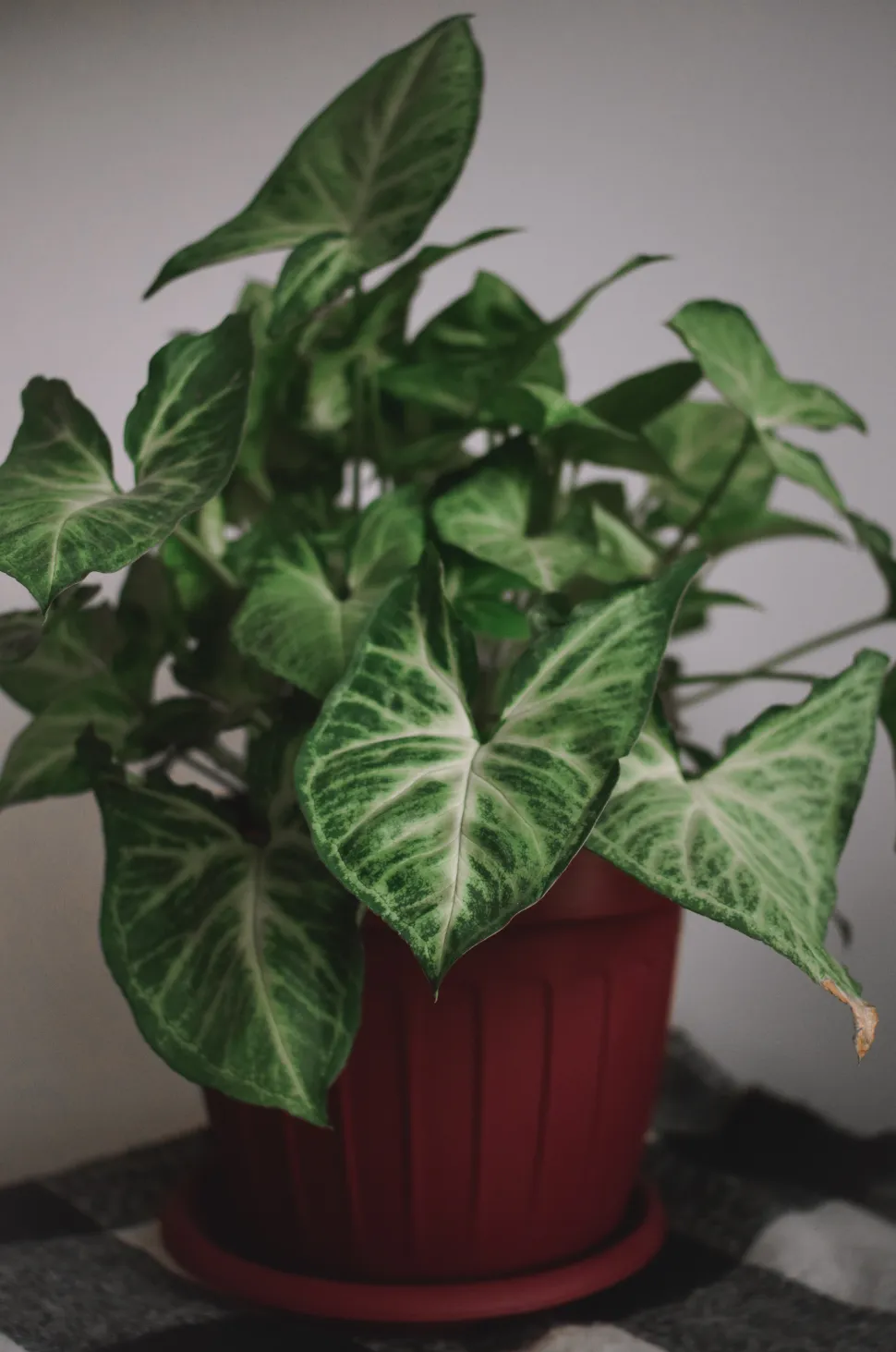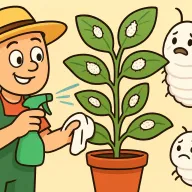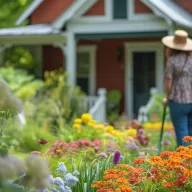
How to use oyas to water indoor plants?
Article for :All parent plants
4,000 years ago, the Chinese and Romans hadn't yet downloaded the Monstera application. To make sure they didn't forget to water, they used oyas. Today, this irrigation technique comes to the rescue of serial plant-killers, overworked plant-addicts and gardeners struggling with more than temperamental varieties.
What is an oya?
Oyas or ollas are ceramic water reservoirs with a stopper. They come in a variety of shapes. Models with elongated ends can be planted in pots or tubs, indoors or out. Jar-shaped models can be buried in the ground, in the vegetable patch or in the garden.
Oyas are made from a porous material (ceramic, clay or terracotta). The density is designed by the potters to optimally diffuse the liquid. When the potting soil is dry, the terracotta releases water. When it's damp, diffusion is interrupted. The plant is irrigated by capillary action. It draws water from the substrate through its roots.

Oyas come in all colors
What are the advantages of ollas?
Ollas let you go on vacation for a few days. Like water-reservoir pots, they provide watering while you're away. When you return, your plants will still be in top form.
Oyas provide just the right amount of water for your plants. Right down to the drop. No more roots rotting from over-watering, or plants dying of dehydration! If you're heavy-handed or dizzy, this accessory could well save your protégés' lives.
Even if you're a pro with a watering can, the olla has its uses. This technique reduces water shock and encourages rooting. Since watering is not only done on the surface, your plant creates deep roots. It's healthier and more resistant.
Another argument, an ecological one this time. Oyas help save water. All the water poured into your reservoir is used. When you water from above, the overflow accumulates in the saucer. With an olla, the surplus is kept until the plant is thirsty.
This watering system is popular in the garden and vegetable patch, as it limits the appearance of fungal diseases such as downy mildew, rust and powdery mildew. At home too, ollas keep foliage and flowers dry and prevent fungus.
Finally, with oyas, you no longer have to move your plant to water it or empty a bowl full of water. If you have a two-metre-high Dieffenbachia 'Camilla or hanging baskets hanging from the ceiling, you can simply refill the olla.

With ollas, you don't have to move the plant to water it or empty the water stagnating in the planter
What are the disadvantages of oyas?
Oyas don't do all the work for you. You have to keep an eye on their level and make sure they still contain a little water. If your memory is closer to that of Dory the fish than Lisbeth Salander, you can rely on the Monstera app. When you receive a watering reminder, refill your reservoir.
Equipping yourself with ollas represents a financial investment. These handmade objects are sold for between 10 and 50 euros. Price depends on capacity and product. Some, engraved, enamelled or coloured, are veritable works of art!
Oyas cannot be used to fertilize plants. It is not advisable to pour liquid fertilizer, even diluted, into your oya. It may damage the material and clog the pores. Solid fertilizers (sticks or granules) also dissolve less well if the substrate is not watered abundantly.
Finally, for certain very thirsty varieties and in hot weather, buried oyas are not enough. You'll still need to water regularly in midsummer.
Which houseplants to water with ollas?

Tired of drowning the roots of your Syngonium? Ollas can save its life.
Plants that require frequent watering and like to keep their soil slightly moist (one to three centimetres) will flourish with an oya. You can use this technique for your :
- Monstera ;
- Pothos ;
- Philodendron ;
- Schefflera ;
- Calathea ;
- Syngonium ;
- Alocasia ;
- maranta ;
- indoor palms ;
- birds of paradise ;
- pachira ;
- ..
On the other hand, oyas are not ideal for cacti and succulents. Haworthiopsis attenuata, sansevieria cylindrica and echeveria elegans thrive in extreme conditions. These xerophytic plants thrive in very dry soil and take advantage of downpours to replenish their water reserves. For them, abundant watering every two or four weeks is best.
Semi-succulent plants with fleshy leaves and those that like their substrate to dry out between waterings also prefer manual watering. Examples include chinese coin plant, Peperomia obtusifolia, saintpaulias and begonias.
Finally, don't give your epiphytic plants an oya. Spanish Moss, tillandsia racket and certain orchids have no use for capillary watering as they have no roots.
How do I use an oya for my green plants?

Instead of watering the substrate, you fill the reservoir.
Ollas come in a range of sizes. Choose the one that corresponds to the surface area to be irrigated and the needs of your specimen. There's no need to invest in a two-litre jar to water a pot ten centimetres in diameter! For indoor plants, three models are generally available in stores and online:
- mini oyas (15 cl) are ideal for small pots, bonsais and plants that don't need much water;
- medium oyas (25 cl) are suitable for most indoor plants;
- large oyas (over 0.5 liters) are reserved for shrubs and large container plants.
Before using your olla for the first time, soak it in water for at least 24 hours. Once soaked, the jar diffuses water more easily. If you skip this step, you'll need to refill your reservoir more often in the first few days.
Before planting your oya, think about its location. You'll need to place it close to the plant, without interfering with its development. If your plant has several rhizomes or has produced offshoots, make sure that the tank benefits everyone. Start by watering the substrate copiously. Next, bury the tip of your oya and leave the round part in the open air.
Remove the cap and pour water into your oya. Close the lid to prevent evaporation. You should check the water level regularly. If it falls below 50%, refill the container.
Whether terracotta, ceramic or clay, oyas are durable and low-maintenance. When you use tap water, white marks appear. This is due to limescale deposits. You can remove them by washing with water and white vinegar.
By Servane Nemetz
on 21-06-2023 at 15h53
on 21-06-2023 at 15h53











